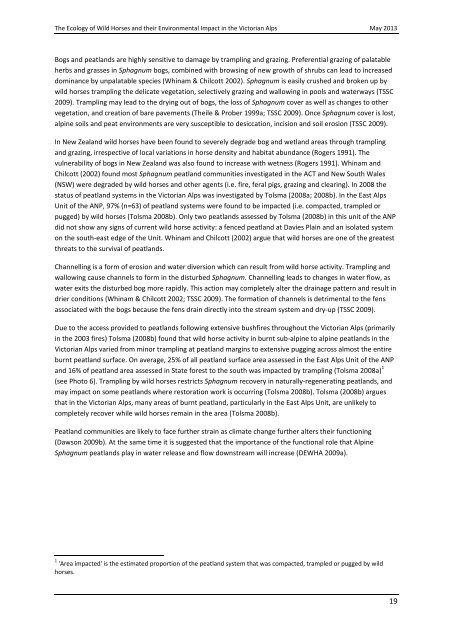The Ecology of Wild Horses and their Environmental ... - Parks Victoria
The Ecology of Wild Horses and their Environmental ... - Parks Victoria
The Ecology of Wild Horses and their Environmental ... - Parks Victoria
You also want an ePaper? Increase the reach of your titles
YUMPU automatically turns print PDFs into web optimized ePapers that Google loves.
<strong>The</strong> <strong>Ecology</strong> <strong>of</strong> <strong>Wild</strong> <strong>Horses</strong> <strong>and</strong> <strong>their</strong> <strong>Environmental</strong> Impact in the <strong>Victoria</strong>n Alps May 2013Bogs <strong>and</strong> peatl<strong>and</strong>s are highly sensitive to damage by trampling <strong>and</strong> grazing. Preferential grazing <strong>of</strong> palatableherbs <strong>and</strong> grasses in Sphagnum bogs, combined with browsing <strong>of</strong> new growth <strong>of</strong> shrubs can lead to increaseddominance by unpalatable species (Whinam & Chilcott 2002). Sphagnum is easily crushed <strong>and</strong> broken up bywild horses trampling the delicate vegetation, selectively grazing <strong>and</strong> wallowing in pools <strong>and</strong> waterways (TSSC2009). Trampling may lead to the drying out <strong>of</strong> bogs, the loss <strong>of</strong> Sphagnum cover as well as changes to othervegetation, <strong>and</strong> creation <strong>of</strong> bare pavements (<strong>The</strong>ile & Prober 1999a; TSSC 2009). Once Sphagnum cover is lost,alpine soils <strong>and</strong> peat environments are very susceptible to desiccation, incision <strong>and</strong> soil erosion (TSSC 2009).In New Zeal<strong>and</strong> wild horses have been found to severely degrade bog <strong>and</strong> wetl<strong>and</strong> areas through trampling<strong>and</strong> grazing, irrespective <strong>of</strong> local variations in horse density <strong>and</strong> habitat abundance (Rogers 1991). <strong>The</strong>vulnerability <strong>of</strong> bogs in New Zeal<strong>and</strong> was also found to increase with wetness (Rogers 1991). Whinam <strong>and</strong>Chilcott (2002) found most Sphagnum peatl<strong>and</strong> communities investigated in the ACT <strong>and</strong> New South Wales(NSW) were degraded by wild horses <strong>and</strong> other agents (i.e. fire, feral pigs, grazing <strong>and</strong> clearing). In 2008 thestatus <strong>of</strong> peatl<strong>and</strong> systems in the <strong>Victoria</strong>n Alps was investigated by Tolsma (2008a; 2008b). In the East AlpsUnit <strong>of</strong> the ANP, 97% (n=63) <strong>of</strong> peatl<strong>and</strong> systems were found to be impacted (i.e. compacted, trampled orpugged) by wild horses (Tolsma 2008b). Only two peatl<strong>and</strong>s assessed by Tolsma (2008b) in this unit <strong>of</strong> the ANPdid not show any signs <strong>of</strong> current wild horse activity: a fenced peatl<strong>and</strong> at Davies Plain <strong>and</strong> an isolated systemon the south-east edge <strong>of</strong> the Unit. Whinam <strong>and</strong> Chilcott (2002) argue that wild horses are one <strong>of</strong> the greatestthreats to the survival <strong>of</strong> peatl<strong>and</strong>s.Channelling is a form <strong>of</strong> erosion <strong>and</strong> water diversion which can result from wild horse activity. Trampling <strong>and</strong>wallowing cause channels to form in the disturbed Sphagnum. Channelling leads to changes in water flow, aswater exits the disturbed bog more rapidly. This action may completely alter the drainage pattern <strong>and</strong> result indrier conditions (Whinam & Chilcott 2002; TSSC 2009). <strong>The</strong> formation <strong>of</strong> channels is detrimental to the fensassociated with the bogs because the fens drain directly into the stream system <strong>and</strong> dry-up (TSSC 2009).Due to the access provided to peatl<strong>and</strong>s following extensive bushfires throughout the <strong>Victoria</strong>n Alps (primarilyin the 2003 fires) Tolsma (2008b) found that wild horse activity in burnt sub-alpine to alpine peatl<strong>and</strong>s in the<strong>Victoria</strong>n Alps varied from minor trampling at peatl<strong>and</strong> margins to extensive pugging across almost the entireburnt peatl<strong>and</strong> surface. On average, 25% <strong>of</strong> all peatl<strong>and</strong> surface area assessed in the East Alps Unit <strong>of</strong> the ANP<strong>and</strong> 16% <strong>of</strong> peatl<strong>and</strong> area assessed in State forest to the south was impacted by trampling (Tolsma 2008a) 1(see Photo 6). Trampling by wild horses restricts Sphagnum recovery in naturally-regenerating peatl<strong>and</strong>s, <strong>and</strong>may impact on some peatl<strong>and</strong>s where restoration work is occurring (Tolsma 2008b). Tolsma (2008b) arguesthat in the <strong>Victoria</strong>n Alps, many areas <strong>of</strong> burnt peatl<strong>and</strong>, particularly in the East Alps Unit, are unlikely tocompletely recover while wild horses remain in the area (Tolsma 2008b).Peatl<strong>and</strong> communities are likely to face further strain as climate change further alters <strong>their</strong> functioning(Dawson 2009b). At the same time it is suggested that the importance <strong>of</strong> the functional role that AlpineSphagnum peatl<strong>and</strong>s play in water release <strong>and</strong> flow downstream will increase (DEWHA 2009a).1 'Area impacted' is the estimated proportion <strong>of</strong> the peatl<strong>and</strong> system that was compacted, trampled or pugged by wildhorses.19
















